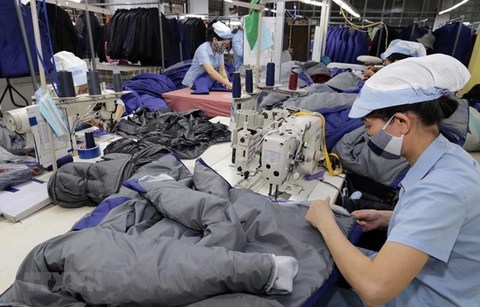
Workers at Duc Giang Garment Company in Ha Noi. Labour productivity is a key factor to promote the country's economy. — VNA/VNS Photo Tran Viet
Viet Nam’s labour productivity has improved but is still low in comparison with other ASEAN members, according to a report by the Ministry of Planning and Investment.
The report shows that Viet Nam’s labour productivity index reached VND102.2 million (US$4,400) per labourer in 2018, nearly double that of 2011. In the period 2011-18, the country’s labour productivity increased by an average of 4.88 per cent annually, in which the period of 2016-18 witnessed an average increase of 5.77 per cent annually.
However, in comparison with other countries in ASEAN, Viet Nam's labour productivity is still low. This means that Viet Nam’s economy is facing a huge challenge to catch up with other countries. If measured by purchasing power parity (PPP) value in 2018, Viet Nam’s labour productivity reached US$11,142, only 7.3 per cent of Singapore, 19 per cent of Malaysia, 37 per cent of Thailand, 44.8 per cent of Indonesia, and 55.9 per cent of the Philippines.
Minister of Planning and Investment Nguyen Chi Dung said improving Viet Nam’s labour productivity is an urgent task, playing an important role to promote growth, overcome the middle income trap, avoid falling behind and narrow the development gap with countries around the world.
However, this task should be solved in the long-term, he added.
Experts said it is necessary to understand the capacity of workers and why Viet Nam’s labour productivity is still low in order to find solutions, which must be radical, effective and comprehensive and capable of covering all causes.
Chairman of the Vietnam Chamber of Commerce and Industry Vu Tien Loc said that Viet Nam’s competition has mainly been based on cheap labour and low costs of raw materials. This has occurred for a long time, making many Vietnamese private enterprises neglect improvements to strategic planning, management skills, and promoting the application of science and technology in production and business as well as increasing capital efficiency.
“In the context that Viet Nam has become a low middle-income country, while the traditional competitive advantages are gradually disappearing, the low labour productivity will be a major cause hampering the country’s investment attraction and international integration,” Loc said.
Professor Kenichi Ohno from the Japan Policy Research Institute said that Viet Nam needs to build an overall strategy to increase labour productivity, moving sustainable labour productivity growth of 7-8 per cent.
He said it should focus on boosting labour productivity in industry first, then on other sectors such as agriculture and services. For countries that receive a large amount of foreign direct investment like Viet Nam, the strategy can target high-quality FDI projects and enhance the competitiveness of domestic manufacturing industries, setting up close links between these two areas.
Ohono said that despite many years of close economic co-operation, Viet Nam has not yet applied any Japanese productivity tools. Some productivity measures such as 5S (sort, set, shine, standardise and sustain) and Kaizen (changing for the better) have been tested at the enterprise level with the support of Japan International Cooperation Agency (JICA), but the scale is too small and only lasts a short time.
General Director of Duc Giang Chemical Joint Stock Company Dao Huu Huyen said the State needs to have suitable policies, creating conditions for a number of "leading" enterprises to make breakthroughs and promoting small- and medium-sized enterprises for development.
“This will be an effective and practical way to promote labour productivity in enterprises,” Tuyen said.
According to Chairman of Thien Phu Energy Investment Joint Stock Company Tran Anh Dung, to increase labour productivity when Viet Nam and many countries in the region and around the world are catching up with Industry 4.0, businesses need to make efforts to raise their level, actively applying technology in production and business and encouraging creative ideas in every activity.
“In the Vietnamese business community, young businesses and start-ups need to raise awareness about technology and labour discipline, which is the most effective and practical solution to boost labour productivity,” Dung said. — VNS